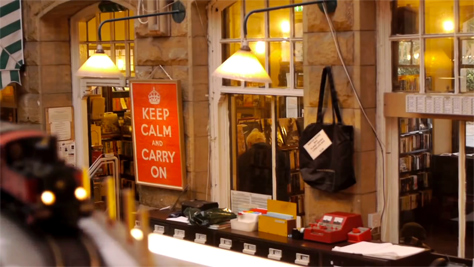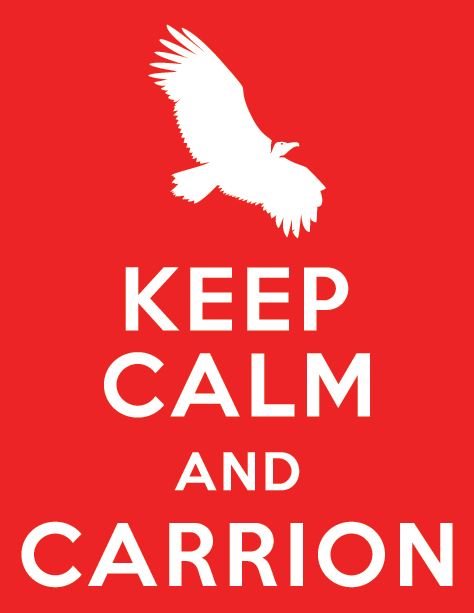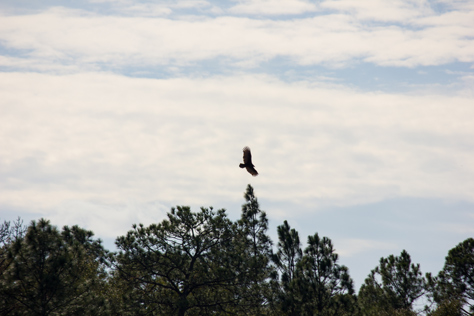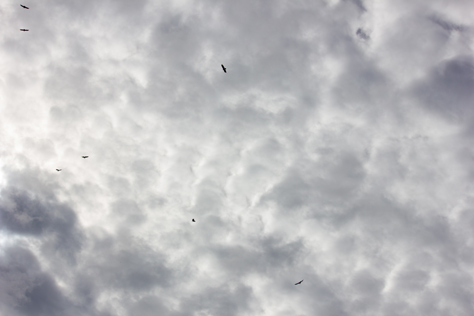Turkey vulture (Cathartes aura) circling in the skies above Pebble Lake from the overlook pavilion near the picnic area at Mike Roess Gold Head Branch State Park.
Near 6239 State Road 21, Keystone Heights, Florida: 18 January 2015
part of the Mike Roess Gold Head Branch State Park album
In the three years leading up to their 1939 declaration of war on Germany, the government of the United Kingdom secretly planned and developed the Ministry of Information. A centralized agency from which national propaganda and news releases could be crafted and distributed, a Ministry of Information was first briefly established in 1918 near the end of the Great War.
Correctly predicting the difficult times ahead, one of the earliest tasks assigned to the Ministry of Information by government leaders was to create a series of morale boosting posters that could be displayed in public across Britain. Simple, bold and featuring a graphic of the Tudor Crown[1], three posters were initially designed and produced between 27 June and 06 July 1939.

keepcalmandcarryon.com
Displaying the slogans "Freedom Is In Peril / Defend It With All Your Might" and "Your Courage / Your Cheerfulness / Your Resolution / Will Bring Us Victory", the first two posters were distributed within twenty-four hours of the war declaration and posted on public transport, notice boards and in shop windows nationwide.
After "reports on civilian morale pointed to boredom rather than dislocation" and unease with the phrase, it was decided to hold back a third poster bearing "Keep Calm and Carry On" from the public. About 2.5 million copies of "Keep Calm" had been printed and shipped to distribution centers, but not displayed.
Attacked by parliamentarians for "failing to understand publicity" and by the press for wasting money[2] and paper, the entire campaign was terminated after four weeks. The unused "Keep Calm" posters were later destroyed in 1940 as part of the country's Paper Salvage program (1939–1950).
Fast forward sixty years to Barter Books in Alnwick, Northumberland owned by Stuart and Mary Manley. One day while going through a box of old books purchased at auction, Stuart discovered an original copy of "Keep Calm" folded up at the bottom. Liking the poster but not realizing its historical significance, Stuart and Mary framed and hung it in their shop. It was so popular with their customers that they started selling reproductions in 2001.

Barter Books
For whatever reason, the poster struck a chord with the modern world and soon other reproductions, parodies and homages were everywhere. As of February 2009, the Manleys had sold "more than 40,000 copies, as well as mugs, T-shirts, mouse mats, tea towels and postcards." It was thought that the only other original lithographs were at the Imperial War Museum, holding several copies in two sizes: PST 14847 at 751×501 mm and PST 14842 at 378×251 mm.
Like the Manleys, Moragh Turnbull of Cupar, Fife did not think much about the "Keep Calm" poster or appreciate its significance until she brought one to a recording of Antiques Roadshow at St. Andrews University in February 2012.
Turnbull explained that she had about fifteen "Keep Calm" posters which were passed down from her father William, who had been given them while serving in the Royal Observer Corps. Antiques expert Paul Atterbury explicated the history and informed Turnbull, much to her surprise, of the unique nature of her collection — the largest surviving cache known to exist.
Beyond those in the Imperial War Museum collection and held by the Manleys and Turnbull, there are no other known original copies of the "Keep Calm" poster. Almost certainly there are a few others out there boxed in attics, just waiting to be discovered. In the meantime, the phrase and poster carry on in mainstream popular culture in Britain and worldwide.
Always a fan of paronomasia, I jokingly said the phrase "Keep Calm and Carrion" to my mother after spotting turkey vultures during an October 2014 camping trip. I also made an offhand remark about making a poster of it. While not an original idea, I decided to go ahead and make good on that remark.
It took some searching, but I recently found a free vector image of a vulture in flight that resembled the one in my mind. With that and the excellent "Keep Calm" font by Keith Bates in hand, I was able to make a mock-up in Photoshop followed by a vector drawing in Illustrator.

Keep Calm and Carrion
by David July
Vulture by Vector Portal
Typeface by Keith Bates
1.09 MB
248 KB
The artwork package contains the Illustrator AI vector original, formatted for print and ready for custom-sized export, along with six sizes of PNG.
| ◼ 200×259 | |
| ◼ 474×613 | |
| ◼ 1024×1325 | |
| ◼ 1920×2485 | |
| ◼ 2550×3300 | 8.5×11″ |
| ◼ 5100×6600 | 17×22″ |
If you print a copy of the poster or use it online, I would love to hear from you.
[1] Some refer to this incorrectly as Saint Edward's Crown. King Edward VII requested the standardization of the Tudor Crown image, the result of which was the Crown of King George VI design used in official emblems and "representing the sovereign source of governmental authority" from 1902 to 1953. Upon her accession in 1952, Elizabeth II requested a design change to the current version modeled after Saint Edward's Crown. Comparing the two and considering the timeline, the poster's Tudor Crown is clearly the low arched George VI version.
[2] At least £45,000 GBP was spent on the posters, a value today of £2,056,474. At current exchange rates, £0.655 equals $1.00 USD. In contrast, the UK Bomber Command likely spent around £8,900,000 on aluminum to build new aircraft from 1938 to 1945. The poster cost is 23% of that amount.
Photo Credit: keepcalmandcarryon.com
Photo Credit: Barter Books
Photo Credit: David July
Photo Credit: David July








